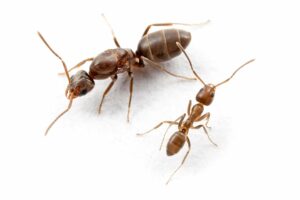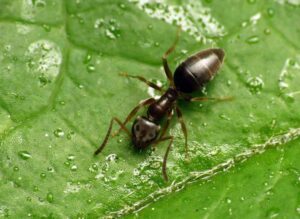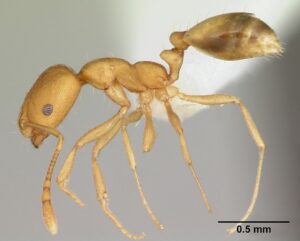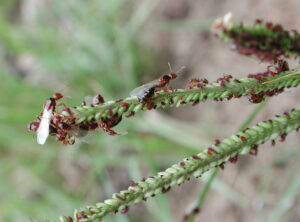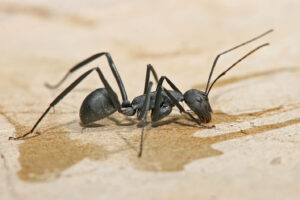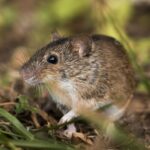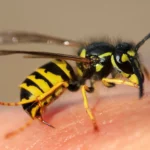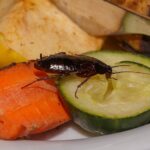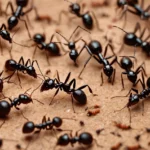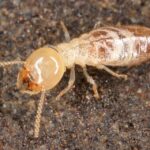Home » Pest Guide » Ants
Ants
Ants in Florida are one of the most adaptable insects and can be found in nearly every type of environment – from sandy soil to city apartments. Species such as Carpenter Ants, Fire Ants, and Pharaoh Ants each pose different risks, from painful stings to structural damage.
Professional Ant Control
Ant infestations are among the most persistent and frustrating pest problems faced by homeowners and businesses in Florida. These small but organized insects can quickly invade kitchens, walls, and outdoor areas in search of food, water, and shelter. A few visible ants often indicate a much larger hidden colony nearby.
In this comprehensive guide, you’ll learn how to identify different ant species, understand their behaviour and nesting habits, and discover effective prevention and treatment methods that truly work.
Common Ant Species
There are over 12,000 known species of ants worldwide, but only a handful cause problems around homes and businesses. Below are the most common types encountered in South Florida residential and commercial settings:
What Attracts Ants
Ants are social insects that work collectively to find and share resources. They enter homes through even the smallest openings when attracted by:
- Food: crumbs, sugary drinks, pet food, grease, or unsealed containers.
- Water: leaky pipes, condensation, and high-humidity rooms.
- Shelter: wall voids, basements, garden mulch, and soil mounds.
- Vegetation: tree branches and plants touching the structure provide easy access.
Once a scout ant locates a resource, it leaves a pheromone trail that directs the rest of the colony straight to the source.
Signs of an Ant Infestation
Early detection is key to preventing colonies from spreading. Watch for these signs:
- Trails of ants along walls, countertops, or baseboards.
- Small piles of soil or wood shavings (especially from carpenter ants).
- Rustling noises inside walls at night.
- Ant nests in lawns, garden beds, or under pavers.
- Food quickly attracting ants after being left out.
If you see consistent activity for more than a few days, it’s likely a full colony nearby.
Ant Infestation FAQs
Why do ants suddenly appear in my kitchen?
Ants are drawn to food crumbs, sugary spills, and moisture. Once a scout ant discovers a resource, it leaves a pheromone trail for others to follow. Cleaning surfaces and sealing entry points helps, but a professional treatment may be needed if trails persist.
What’s the fastest way to get rid of ants?
The most effective approach is targeted baiting, which allows ants to carry poisoned bait back to the colony. Spraying visible ants can scatter the colony and make things worse. A technician can identify the correct bait type for the species in your home.
Are ants dangerous to humans or pets?
Most ants are harmless, but some species — like Fire Ants — can sting and cause allergic reactions. Carpenter Ants can damage wooden structures over time. It’s important to identify the species early to prevent costly damage or bites.
Can ants damage my property?
Yes. Carpenter ants tunnel through damp wood to build nests, which can weaken structures. Electrical ants may also infest junction boxes and cause shorts. Early inspection prevents serious issues.
How can I keep ants away permanently?
Regular cleaning, sealing entry points, fixing leaks, and storing food properly all help prevent infestations. Combining these steps with scheduled pest control services offers the most reliable long-term protection.
Do DIY ant sprays work?
They can kill visible ants temporarily but rarely eliminate colonies. In most cases, DIY sprays cause colony splitting or relocation, making the problem harder to control. Professionals use non-repellent treatments designed to reach the queen and entire nest.
Get Your Free Ant Control Quote
Seeing ant activity around your home or business? Our licensed pest control specialists locate nests, eliminate entire colonies, and keep them from coming back. We use safe, targeted treatments that work for any type of ant — indoors or outdoors.
Don’t wait until the infestation spreads — request your free quote today and protect your property year-round.
Ant Behaviour and Nesting Habits
Ants live in highly organized colonies made up of:
- Workers: gather food and maintain the nest.
- Queens: reproduce and expand the colony.
- Males: mate and die shortly after.
Colonies can contain thousands of ants, often with multiple nesting sites connected through underground tunnels or wall cavities. Some species relocate quickly when disturbed, making DIY treatments unreliable.
How to Get Rid of Ants
There’s no one-size-fits-all solution. Effective control depends on species, nesting location, and infestation level.
🏠 Indoor Treatment:
- Clean up all food debris and wipe surfaces regularly.
- Seal cracks, crevices, and entry points.
- Use ant bait stations near trails — never spray directly, as this splits colonies.
- Keep pet food sealed and water bowls elevated.
🌳 Outdoor Treatment:
- Trim vegetation touching the structure.
- Remove wood piles and decaying debris.
- Apply targeted bait or non-repellent insecticides to nests and entry areas.
Ant Prevention & Proofing Tips
The best long-term protection is prevention:
- Keep kitchen areas clean and dry.
- Store food in airtight containers.
- Fix leaky pipes and improve ventilation.
- Seal foundation cracks and window gaps.
- Maintain a 6-inch barrier between soil and siding.
- Schedule routine inspections with a professional technician.

When to Call a Professional
DIY products can reduce visible ants temporarily, but they rarely eliminate the entire colony – especially with species like Carpenter Ants or Pharaoh Ants that nest deep inside walls.
A licensed pest technician can identify the exact species, locate hidden nests, and apply safe, targeted treatments that remove the problem at its source.
Do you have another Pest Issue?
What our Customers Say about Us!
Trustindex verifies that the original source of the review is Google. Great service for the price tbhTrustindex verifies that the original source of the review is Google. Goat services and didn’t have a problem ever sense.Trustindex verifies that the original source of the review is Google. Best service hands down!! As a first time customer, all I know is this they definitely got the job done and will be recommending them to everyoneTrustindex verifies that the original source of the review is Google. I been having a bugs everywhere and been terrified and they help me so much getting the bugs awayTrustindex verifies that the original source of the review is Google. Did an amazing job helping me with my ants .Trustindex verifies that the original source of the review is Google. I was having problems with my roaches in my house and they did a good job getting rid of emTrustindex verifies that the original source of the review is Google. this man does really good he killed all the pests in my house 😮🫡Trustindex verifies that the original source of the review is Google. Very accommodating for emergency service request. Also prompt in time for appointments. Great company!!Verified by TrustindexTrustindex verified badge is the Universal Symbol of Trust. Only the greatest companies can get the verified badge who has a review score above 4.5, based on customer reviews over the past 12 months. Read more


